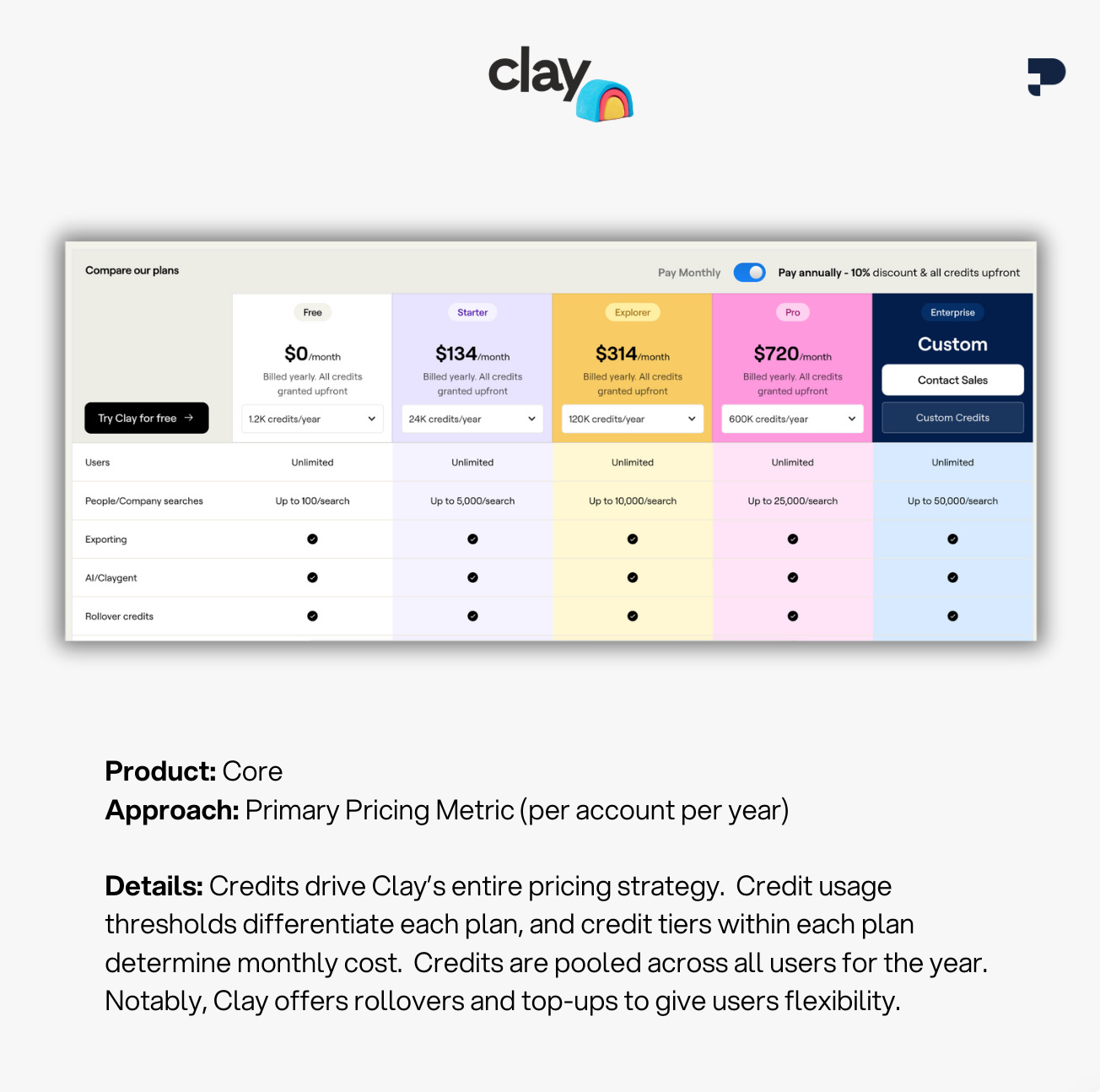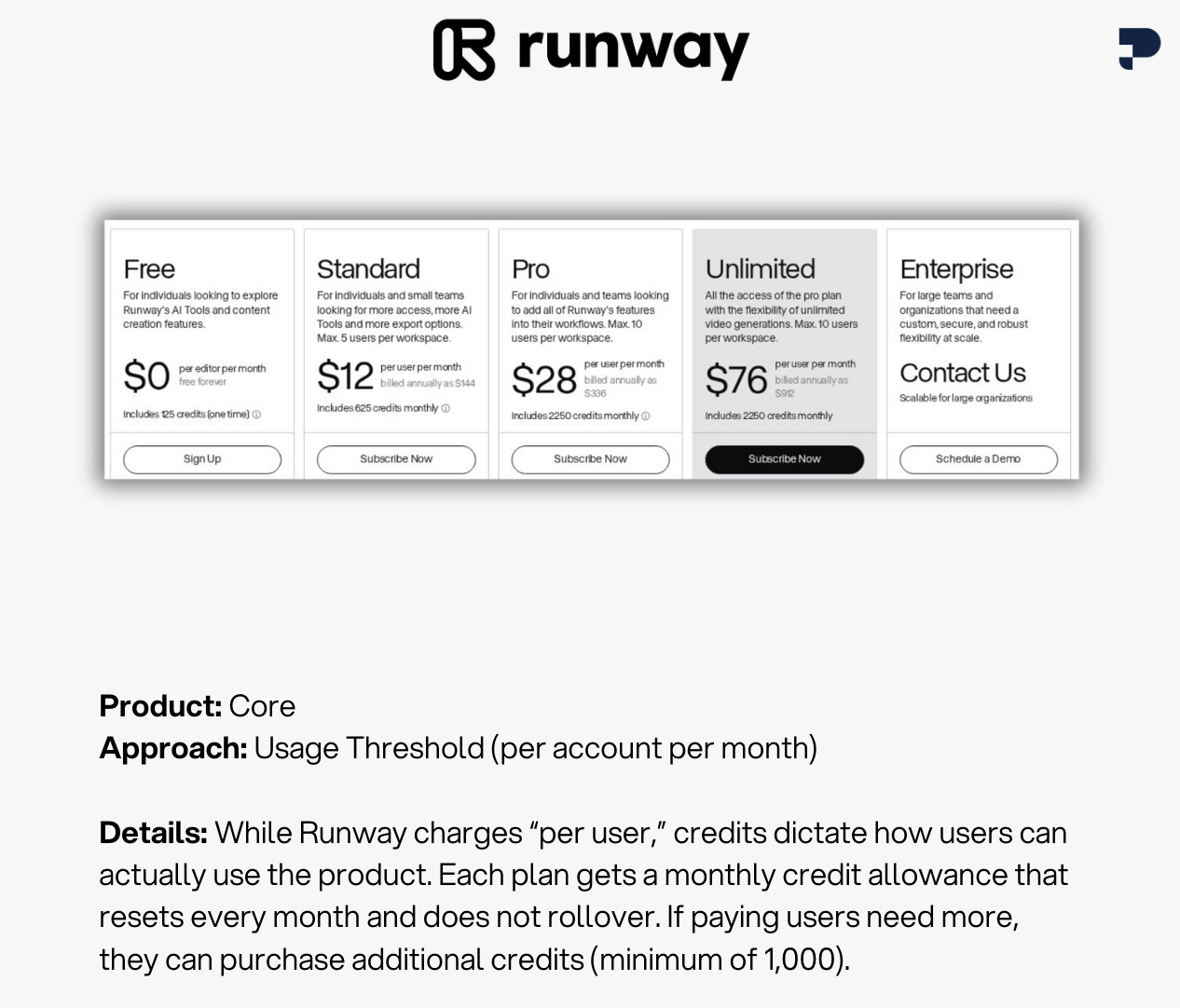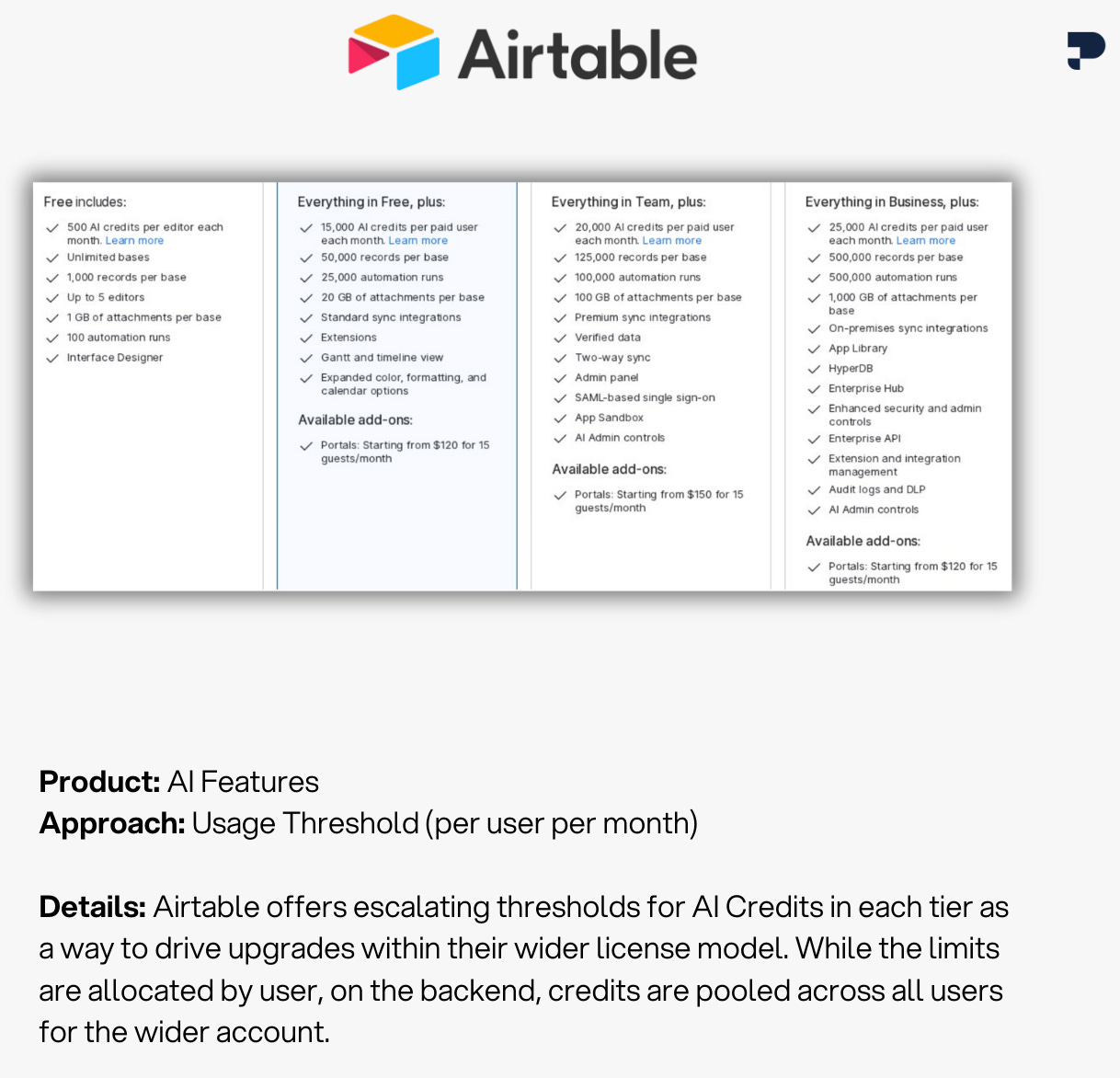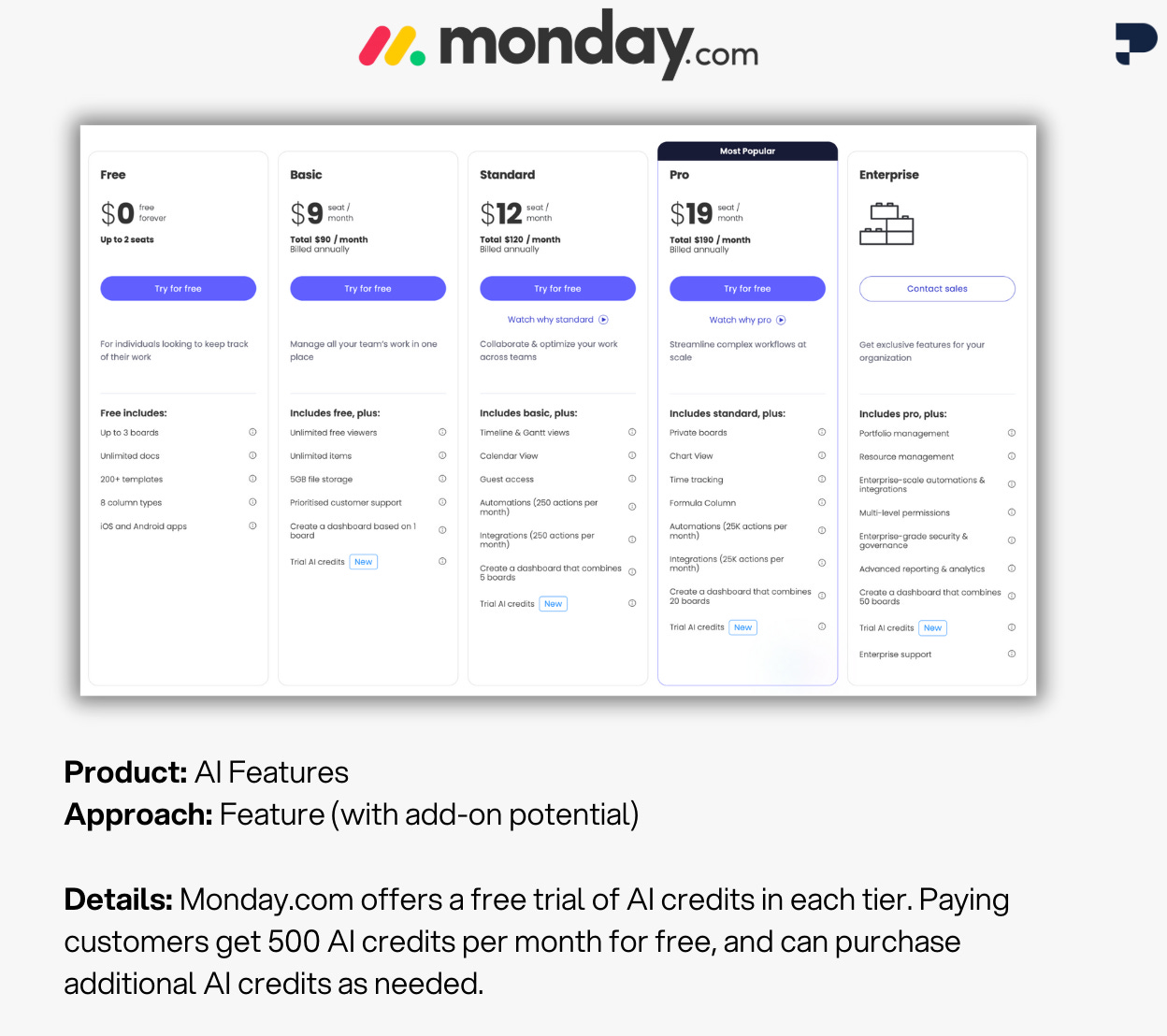How to Use Credit Models (12+ Examples)
Plus: Introducing Swipe Files.
Welcome back to Good Better Best!
This week we introduced a new content format: Swipe Files.
Our objective is to dig into the PricingSaaS database and find real-life examples of a specific pricing tactic, then share what we find. This week, we broke down how companies are implementing credits — specifically how they’re using credit and license pricing modalities together.
Below, we’ll break down the four patterns we’re seeing, with examples and analysis. Make sure to grab the full Swipe File to see examples from 12+ companies, along with detailed context on how their credit models work (e.g., pricing tables and credit consumption charts).
Modern value. Legacy monetization. Something’s gotta give.
AI-native products are delivering value in new ways, but most companies are still pricing like it’s 2015. The result is a widening gap between how value is delivered and how revenue is captured. Metronome’s latest whitepaper introduces the Monetization Operating Model: a system that aligns product, finance, and GTM around outcome-based pricing, continuous iteration, and real-time revenue strategy.
How SaaS Leaders Use Credit Pricing Models
As SaaS leaders continue pushing towards agentic products, credit models have become an increasingly popular way to move down the value chain from inputs to outcomes.
Credits deliver the holy grail of SaaS pricing: usage-based fairness without billing chaos. They allow customers to pay for what they consume within predictable spending guardrails, and they offer companies a flexible path to implementation.
Want to experiment with freemium?
Test new features?
Offer an add-on?
Credits are adaptable. And while they often require sophisticated modeling (e.g., Autofill = 1 credit, Auto Create a Formula = 5 credits), actions and tasks are easier to define and execute than outcomes.
The Four Implementation Models
Some quick definitions to clarify what we mean by “pricing modality.”
A pricing modality is the method by which you charge customers. In SaaS there are four core modalities:
Flat Fee: Same amount no matter how much customers use now or in the future.
License: Gives customers the right to use something; purchased before use.
Usage: Based on your customers consumption; paid after use.
Credit: Hybrid between license and usage. Credits give customers a right to consume or use something at a later stage, but the usage is estimated and paid for upfront.
Specifically, we wanted to investigate how SaaS leaders are implementing credits within or alongside a license modality. After analyzing dozens of companies, four patterns emerged. The following examples break down each approach with an example from a leading SaaS company.
1. Pure Credit Model
Companies like Clay, Lovable, and Unify make credits their primary pricing metric.
Clay's entire pricing strategy revolves around credit usage thresholds: different credit volumes determine plan tiers, and credits pool across all users annually with rollovers and top-ups for flexibility.
Lovable takes a different approach within this model, offering both monthly credit limits and daily bonus credits. The monthly limit drives subscription cost while daily bonuses encourage consistent usage.
This approach is all-in mode. It offers maximum flexibility, direct value-to-price alignment, and scales naturally with usage. On the downside, it also requires sophisticated credit modeling (each of these companies has detailed pricing tables highlighting credit value), can create operational headaches around rollovers and top-ups, and can require customer education.
2. Credit Pricing Metric
Runway takes this approach. Each tier has a per user cost, with a credit allocation that defines how much customers can use the product. Each plan includes monthly credit allowances that reset without rollover, with additional credits available for purchase.
Runway credits are also pooled across the account, similar to Clay and Lovable, but the biggest difference is that customers pay a “per user” fee to access the credits rather than just paying a fee for access to the credit pool.
While per user pricing is easy to understand on the surface, this creates a weird dynamic where a company can add users, incurring a higher monthly cost, but the credit pool stays the same.
In their help docs, Runway actively encourages collaborators to create a new workspace rather than joining an existing one to avoid draining the credit pool too quickly.
3. Credit Usage Threshold
Airtable and Asana use this approach, bundling escalating credit thresholds within traditional seat-based license tiers.
Airtable offers increasing AI credit allowances across plans (500 for Free, up to 25,000 for Business), using these limits to drive natural tier progression.
Similarly, Asana escalates AI Studio credit limits by tier while allowing additional credit purchases or upgrades to specialized Studio subscriptions for higher volumes.
This approach offers little risk since it fits within the existing seat-based license model. It’s also a great way to drive adoption of AI features. The downside is they might not be capturing as much value as they could if they monetized credits independently.
4. Credit Add-On (with trial)
Companies like Monday.com and Caspio use this approach. Rather than rationing out escalating usage thresholds for each tier, they offer a trial allotment of credits as a "feature" within all plans, and users can purchase more as needed.
For example, Monday.com gives all customers 500 AI credits per month for free, with the option to buy more as needed.
Caspio provides 100 credits for testing but monetizes through add-on blocks (1,000 credits for $20/month or 10,000 for $180/month).
Similar to the usage threshold approach, the trial option is a great way to drive adoption of the features that credits unlock. The upgrade path (e.g., in-plan add-on rather than upgrade to a new plan) is also straightforward. It creates less friction since users are getting exactly what they’re paying for, rather than being forced into a new plan.
Depending on what actions consume credits (e.g., AI for Monday) there’s a decent chance these companies are leaving money on the table with customers that don’t reach the limit.
Implementation Insights
Regardless of the approach, successful credit implementations share common characteristics:
→ Transparency is crucial. Companies like Airtable publish detailed credit consumption tables showing exactly how many times customers can run each action within their plan limits.
→ Flexibility drives adoption. Clay's rollover credits and top-up options reduce customer anxiety about usage spikes.
→ Education accelerates success. Lovable explains how credit value scales with task complexity, helping customers understand the value-to-cost relationship.
→ Strategic bundling drives adoption. Monday.com's 500 free monthly credits let customers experience AI features before deciding on additional purchases. Lovable maintains a free daily credit limit, even in paid plans, to incentivize usage.
That’s all for today. For more examples, and detailed breakdowns of pricing tables and credit consumption charts, get the full swipe file and let us know what you think.
Thanks for reading! When you’re ready, here’s how we can help:
PricingSaaS Community: Join the free PricingSaaS Community to get quick answers from experts, real-time pricing data, and access to exclusive events.
PricingSaaS Index: Check out the PricingSaaS Index to track competitors, scroll pricing histories, and create a swipe file of pricing pages for inspiration.
Free Advisory Session: Need a sounding board? Book a 30-minute session. No sales pitch. We’ll provide honest feedback and steer you in the right direction.









Good writeup. A few things I would add is that usage-based pricing isn't the holy grail; outcome-based pricing is and very few have been able to pull that off. Having been early in the SaaS revolution, companies expect usage to continue to grow. Unfortunately, you hit a breaking point where companies start pulling back access and limiting usage. You also see much more multi-vendor solutions in companies that buy on usage. For example, if it costs me a credit to enter an opportunity into my CRM, that's great for a large deal. However, if that 1M is is worth the price of that credit, is a $1,000 deal?
I do think that the industry would well for itself if they agreed on a standard monetary value of a credit as well as provide more visibility into the credit costs of the action. If I'm having a document rewritten by AI and its going to use $100 in credits, I may choose to do it on my own.
All of this will be more interesting as we progress in AI infrastructure. At least a couple of "AI providers" are building their own powerplants to fuel the data center and several are contracting for cooling it. As those come online, costs should become more predictable.
Just make the pricing agent so we can all just drop in our URLs and we can get scored + suggest the best model to use 🙏🏽🙏🏽🙏🏽